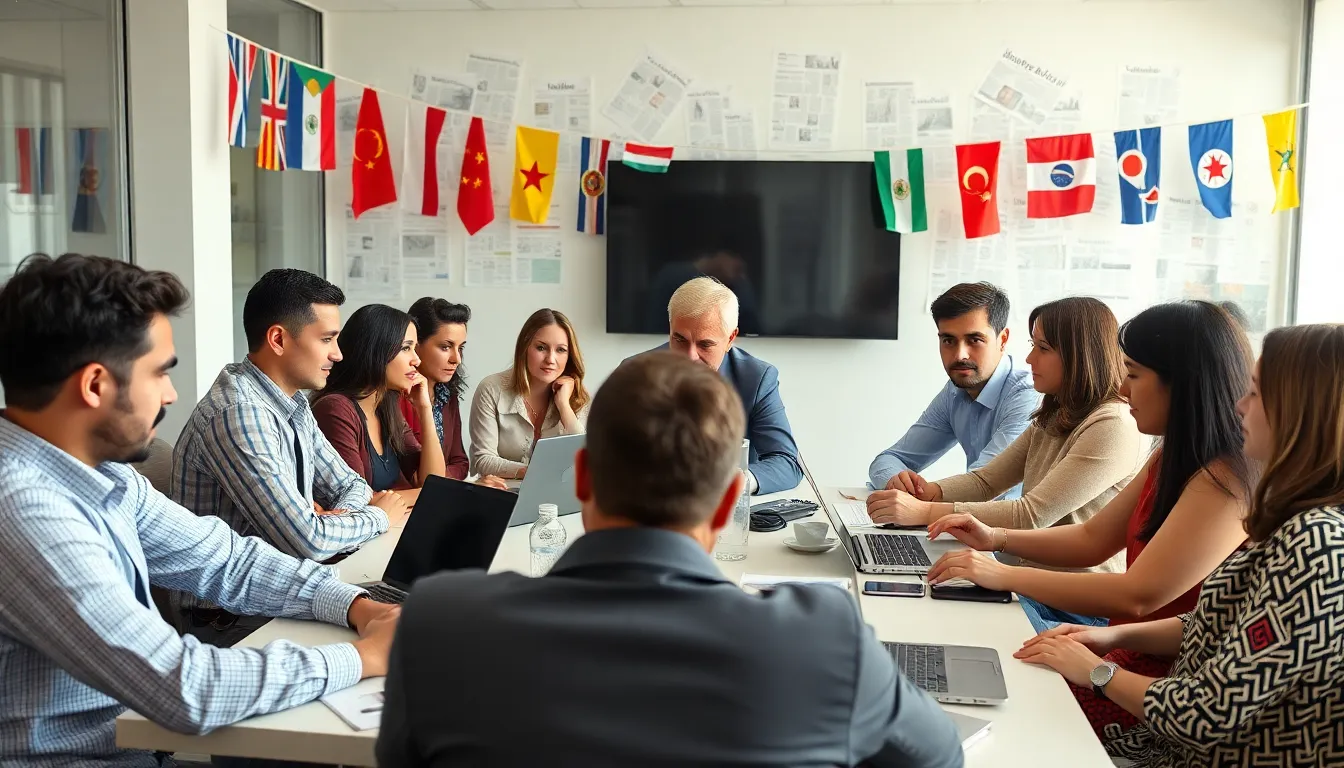In an increasingly interconnected world, international news analysis plays a crucial role in shaping public perception and understanding of global events. With headlines often dominated by conflict, politics, and economic shifts, it’s essential to dig deeper and grasp the underlying factors at play. This analysis not only informs but also empowers individuals to engage with the complexities of global affairs.
As news travels faster than ever, the challenge lies in discerning fact from sensationalism. A thorough examination of international news enables readers to navigate the noise and develop a well-rounded perspective. By exploring diverse viewpoints and expert insights, they can appreciate the intricate web of relationships that define our global landscape.
Table of Contents
ToggleUnderstanding International News Analysis
International news analysis involves a comprehensive examination of global events, considering various factors and perspectives. This approach enhances understanding of the complex dynamics that shape today’s world.
Definition and Importance
International news analysis refers to the critical evaluation of news stories from around the globe. It emphasizes context, sources, and implications rather than surface-level coverage. This analysis plays a vital role in providing clarity on issues that impact international relations, economics, and cultural exchanges. Readers gain insight into how these elements interconnect and influence global stability.
Key Components
- Contextual Background
Contextual background offers historical and sociopolitical information relevant to current events. Providing this context helps readers identify the roots of conflicts and the stakes involved.
- Diverse Perspectives
Diverse perspectives encourage the inclusion of viewpoints from various stakeholders. These include political leaders, experts, and affected populations. This breadth of viewpoints enriches the analysis and allows for a more balanced understanding of the issues.
- Fact-Checking
Fact-checking is essential in distinguishing factual information from misinformation. Reliable sources and data verification enhance credibility and inform readers accurately about global matters.
- Implications and Outcomes
Implications and outcomes involve analyzing potential consequences of current events. Understanding these outcomes allows readers to anticipate future developments and their global impact.
- Expert Insights
Expert insights draw on analyses from scholars and practitioners in international relations. Such insights provide depth and credibility, aiding readers in grasping complex situations.
The Role of Media in International News

Media plays a crucial role in shaping perceptions of international events. The evolution of communication technologies significantly impacts how audiences consume news on a global scale.
Traditional Media vs. Digital Media
Traditional media outlets, such as newspapers and television networks, emphasize in-depth reporting and journalistic standards. These platforms often employ experienced journalists who investigate and provide thorough analysis. In contrast, digital media thrives on speed and accessibility, allowing real-time updates and instant sharing of news. However, this rapid dissemination can sometimes lead to incomplete or unverified information. Both forms of media offer distinct advantages and drawbacks; traditional media often focuses on context while digital media can provide immediate coverage.
| Type of Media | Advantages | Drawbacks |
|---|---|---|
| Traditional Media | In-depth analysis, journalistic integrity | Slower updates, limited reach |
| Digital Media | Instant updates, wide accessibility | Potential for misinformation, lack of depth |
Bias and Representation
Bias in media coverage affects how international news is perceived and understood. Different outlets may prioritize specific narratives based on their editorial stance, influencing representation of events. Diverse viewpoints are essential to provide a balanced perspective. Ensuring representation of various voices, including marginalized communities and affected populations, helps illuminate the complexities of global issues. Audiences benefit from critically assessing media sources and recognizing biases to form a comprehensive understanding of international affairs.
Methods of Analyzing International News
Analyzing international news involves various methods that enhance understanding of global events. Two primary approaches include qualitative analysis and quantitative analysis, each offering unique insights.
Qualitative Analysis
Qualitative analysis focuses on understanding the context and meaning behind international news stories. It involves examining narratives, themes, and language used in the coverage. Analysts consider:
- Contextual Background: Analyzing historical events, cultural nuances, and political dynamics that influence current events.
- Thematic Analysis: Identifying recurring themes in news reports to uncover underlying messages or agendas.
- Source Credibility: Evaluating the reliability of sources, including government statements, expert opinions, and eyewitness accounts, to assess bias and motivations.
- Interviews and Surveys: Gathering perspectives from stakeholders, experts, and affected populations to gain comprehensive insights into the implications of news events.
Quantitative Analysis
Quantitative analysis emphasizes statistical data and measurable factors affecting international news. It utilizes numerical methods to assess patterns and trends. Key components include:
- Data Collection: Gathering relevant data from reliable databases, surveys, and international organizations to support findings.
- Statistical Evaluation: Applying statistical methods to identify correlations, trends, and anomalies in news coverage and global events.
- Content Analysis: Quantifying the frequency of specific terms or themes across multiple news sources to assess media representation and bias.
- Survey Research: Conducting public opinion polls to measure perceptions and attitudes toward international issues, providing empirical evidence for analysis.
Through these methods, analysts can deepen their understanding of complex global narratives, allowing for a more informed perspective on international affairs.
Case Studies in International News Analysis
Analyzing international news through case studies provides insight into significant global events and their broader effects. The following sections explore recent major events and their impact on public opinion.
Recent Major Events
Recent major events illustrate the complexities surrounding international news analysis. The Ukraine-Russia conflict exemplifies how geopolitical tensions escalate, affecting regional security and global alliances. As news coverage fluctuated between timelines of military movements and diplomatic negotiations, analysts sifted through diverse narratives to uncover underlying motivations. In 2023, the ongoing crisis in Myanmar has demonstrated how authoritarian regimes suppress dissent and manipulate information. Coverage spotlighted the humanitarian aspect while analyzing the international community’s response, influencing perceptions of legitimacy and governance.
The COVID-19 pandemic offers another critical case study, showcasing how health crises shape international relations. News reports highlighted the vaccine disparity between nations, prompting discussions on global equity. Journalists examined data from various sources, presenting a comprehensive picture of health policies and their implications for international cooperation.
Impacts on Public Opinion
The way international events are framed in news reports significantly influences public opinion. Coverage of the Black Lives Matter movement highlighted systemic racism and prompted global discussions on social justice. Media outlets that presented diverse perspectives contributed to heightened awareness and advocacy for policy changes.
Areas plagued by ongoing conflicts, such as the Middle East, experience polarized public opinions due to selective reporting. For instance, coverage that emphasizes violence without context can lead to misinformed perceptions of entire populations. Analysis demonstrated that balanced reporting can foster empathy and understanding, while biased narratives may intensify divisions.
In the digital age, social media profoundly shapes public opinion regarding international events. Platforms like Twitter and Facebook facilitate the rapid dissemination of information, but they also propagate misinformation. Analysts emphasize the importance of critical media literacy to help audiences distinguish credible sources from unreliable ones.
The Future of International News Analysis
International news analysis continues to evolve, driven by technological advancements and changing audience expectations. As global events accelerate, analysts adapt their methods to address emerging complexities in the news landscape.
Emerging Trends
Analysts observe several emerging trends in international news analysis.
- Increased Use of Artificial Intelligence (AI): AI tools provide deeper insights through data analysis and pattern recognition, enhancing the speed and accuracy of reporting.
- Focus on Fact-Checking: Misinformation challenges the credibility of news sources, prompting a stronger emphasis on rigorous fact-checking to maintain public trust.
- Diversification of Sources: Analysts incorporate a broader range of voices, including grassroots organizations and local media, to capture diverse perspectives on global issues.
- Visual Data Representation: The use of infographics and visual storytelling presents complex information in an easily digestible format, improving audience engagement with international news.
- Interactive Platforms: News organizations integrate interactive elements, enabling audiences to explore data and narratives, which fosters a more profound understanding of intricate global events.
Challenges Ahead
While opportunities abound, significant challenges persist in the realm of international news analysis.
- Combatting Misinformation: The proliferation of false information complicates the ability to discern accurate news, requiring analysts to adopt more sophisticated verification techniques.
- Maintaining Objectivity: Bias in news coverage often skews perceptions of international events, necessitating conscious efforts to present balanced viewpoints.
- Adapting to Changing Technologies: Rapid technological changes demand continuous learning and adaptation from analysts to leverage new tools effectively.
- Resource Constraints: Many news organizations face budget cuts, forcing analysts to operate with limited resources while striving to produce high-quality analysis.
- Global Political Tensions: Increasing geopolitical conflicts may restrict access to information and present ethical dilemmas for analysts as they navigate sensitive reporting environments.
International news analysis plays a vital role in navigating today’s complex global landscape. By moving beyond sensational headlines and focusing on context and diverse perspectives, readers can develop a deeper understanding of current events. The challenges of misinformation and bias underscore the importance of critical evaluation and fact-checking in news consumption.
As technology evolves and audience expectations shift, the methods of analysis must adapt. Employing both qualitative and quantitative approaches enhances insights into global narratives. With the right tools and a commitment to thorough evaluation, individuals can better comprehend the intricate relationships shaping international affairs. Staying informed is essential for fostering a well-rounded perspective on the world’s ever-changing dynamics.









